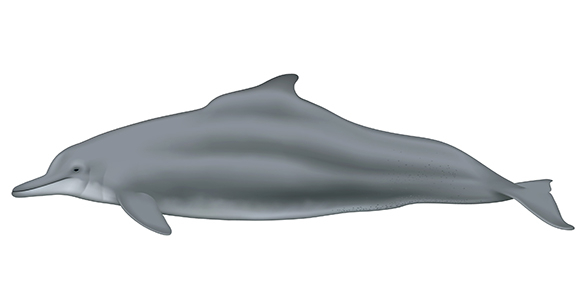
Washington, DC—The National Marine Fisheries Service (NMFS) announced a proposed rule today to list the Atlantic humpback dolphin under the Endangered Species Act, in response to a 2021 petition filed by the Animal Welfare Institute, the Center for Biological Diversity, and VIVA Vaquita. Following a 60-day public comment period, NMFS has until April 2024 to make a final decision on protections.
The Atlantic humpback dolphin (Sousa teuszii) is the most endangered of the four species of coastal humpback dolphins, which are all threatened by human activities. The species is found only along the western African coast, ranging through at least 13 countries’ waters from Western Sahara south to Angola.
Scientists estimate that no more than 3,000 Atlantic humpback dolphins remain, in fragmented groups of tens to hundreds of animals, and the species is already recognized as Critically Endangered on the International Union for Conservation of Nature (IUCN) Red List.
Atlantic humpback dolphins are among the least-known species of dolphins in the world, and this has hindered implementation of effective conservation measures. Current measures aimed at protecting this species are woefully inadequate. Although some countries in the dolphins’ range have established marine protected areas, few laws or regulations exist specifically to conserve the species.
“We are very pleased that NMFS has recognized the need to extend ESA protections to this little-known dolphin,” said Dr. Naomi Rose, AWI’s marine mammal scientist. “This listing would improve the species’ survival prospects, increase global awareness, and generate funds for important science during this unprecedented extinction crisis.”
In December 2021, after a positive “90-day finding” on the petition, NMFS began a status review to determine whether the dolphin should be listed under the ESA. Following that review, NMFS “determined that the Atlantic humpback dolphin has a high risk of extinction throughout its range and warrants listing as an endangered species.”
“Cetaceans, like most groups of large charismatic mammals, are under assault by human activities,” said Dr. Thomas A. Jefferson, marine mammal biologist for VIVA Vaquita. “The announcement by NMFS that the Atlantic humpback dolphin is being recommended for Endangered status under the ESA is great news. Such a listing will surely help those dedicated biologists and conservationists who are working hard to prevent this species from becoming extinct!”
Atlantic humpback dolphins, with distinctive humps on their backs topped by rounded dorsal fins, live exclusively in relatively shallow waters and are most common in estuarine environments close to shore. They feed on a wide variety of nearshore fish species, favoring mullet. This often puts them in direct conflict with human activities in these same areas.
The major threat to the dolphins is bycatch by local gillnet fisheries. Fisheries also deplete the dolphins’ prey. Other major threats are coastal development and noise from human activity in the coastal marine environment. Demand for Atlantic humpback dolphin meat is also apparently on the rise amid a burgeoning African aquatic wild meat trade.
“I’m delighted that the U.S. government is moving forward with protections for this gravely imperiled dolphin,” said Sarah Uhlemann, international program director at the Center for Biological Diversity. “Dolphins and whales around the globe continue to be caught and killed in fishing nets, and the United States recognizing Atlantic humpback dolphins’ Endangered status will shine a spotlight on this threat.”
Marjorie Fishman, Animal Welfare Institute
[email protected], (202) 446-2128
Sarah Uhlemann, Center for Biological Diversity
[email protected], (206) 327-2344
Dr. Thomas A. Jefferson, VIVA Vaquita
[email protected], (858) 945-4240
The Animal Welfare Institute (awionline.org) is a nonprofit charitable organization founded in 1951 and dedicated to reducing animal suffering caused by people. AWI engages policymakers, scientists, industry, and the public to achieve better treatment of animals everywhere—in the laboratory, on the farm, in commerce, at home, and in the wild. Follow us on Facebook, Twitter, and Instagram for updates and other important animal protection news.
The Center for Biological Diversity (biologicaldiversity.org) is a national, nonprofit conservation organization with more than 1.7 million members and online activists dedicated to the protection of endangered species and wild places.
VIVA Vaquita (vivavaquita.org) is a coalition of like-minded scientists, educators, and conservationists, who strive to increase the attention given to the vaquita, the world's most endangered marine mammal species. Our goals and mission are to generate awareness of the vaquita and to promote a healthy Upper Gulf of California ecosystem. We conduct research, public awareness, and education activities to bring this about. Ultimately, we aim to help save the vaquita from extinction, and to do so in a way that also provides long-term benefits to the fisherman and other residents who live around the Gulf of California, Mexico.